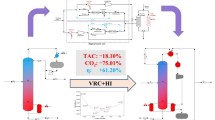Abstract
Distillation is one of the most widely used separation unit operations in process industries, although it is quite energy intensive. In many cases, the enormous energy requirements for distillation make it economically infeasible to carry out the separation. Thermally coupled distillation system (TCDS) is an advanced distillation method that provides significant energy savings of about 30% as compared with conventional distillation column sequences. The most well-known TCDS sequence, the Petlyuk configuration, has some operational challenges due to bidirectional vapour flow, which makes its implementation difficult in two-column mode. To overcome these limitations, a number of unidirectional vapour flow configurations have been proposed in the literature. The work on simulation analysis for such configurations is limited. In this paper, simulation models for two such configurations are developed, analyzed and compared with the Petlyuk and conventional distillation column sequences for separation of equimolar mixture of benzene–toluene–ethylbenzene.













Similar content being viewed by others
References
Hernandez S, Segovia-Hernandez J G and Rico-Ramirez V 2006 Thermodynamically equivalent distillation schemes to the Petlyuk column for ternary mixtures. Energy 32: 2176–2183
Premkumar R and Rangaiah G P 2009 Retrofitting conventional column systems to dividing-wall columns. Chem. Eng. Res. Des. 87: 47–60
Wright R O 1949 Fractionation apparatus, US Patent No. 2471134
Petlyuk F B, Platonov V M and Slavinskii D M 1965 Thermodynamically optimal method of separating multicomponent mixtures. Int. J. Chem. Eng. 5(3): 555–561
Fidkowski Z and Krolikowski L 1987 Minimum energy requirements for thermally coupled distillation systems. AIChE J. 33(4): 643–653
Amminudin K A, Smith R, Thong D Y C and Towler G P 2001 Design and optimization of fully thermally coupled distillation columns. Part 1: preliminary design and optimization methodology. Trans. IChemE Part A 79: 701–715
Yildirim Ö, Kiss A A and Kenig E Y 2011 Dividing wall columns in chemical process industry: a review on current activities. Sep. Purif. Technol. 80: 403–417
Agrawal R and Fidkowski Z T 1998 More operable arrangements of fully thermally coupled distillation column. AIChE J. 44(11): 2565–2568
Fidkowski Z and Krolikowski L 1986 Thermally coupled systems of distillation columns: optimization procedure. AIChE J. 32(4): 537–546
Acknowledgements
Authors are thankful to Council for Scientific and Industrial Research (CSIR) for supporting the present work.
Author information
Authors and Affiliations
Corresponding author
Rights and permissions
About this article
Cite this article
Saxena, N., Mali, N. & Satpute, S. Study of thermally coupled distillation systems for energy-efficient distillation. Sādhanā 42, 119–128 (2017). https://doi.org/10.1007/s12046-016-0580-x
Received:
Revised:
Accepted:
Published:
Issue Date:
DOI: https://doi.org/10.1007/s12046-016-0580-x




